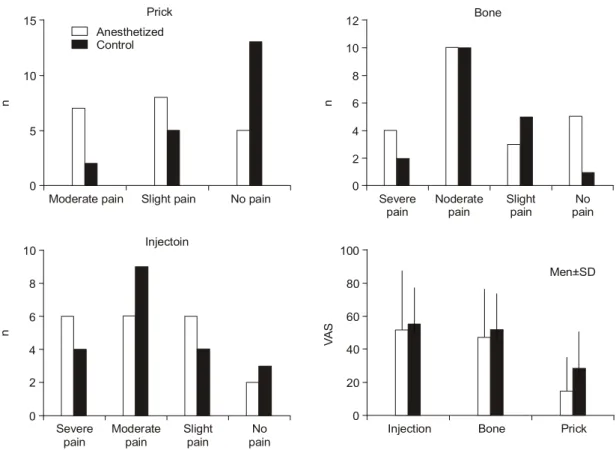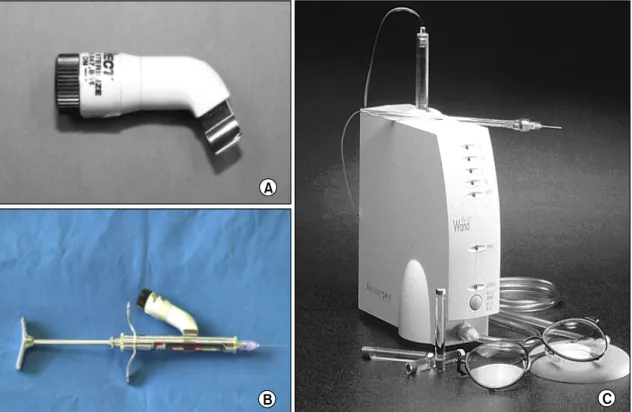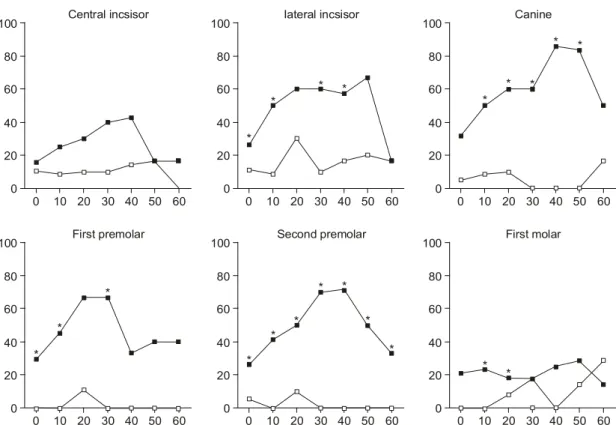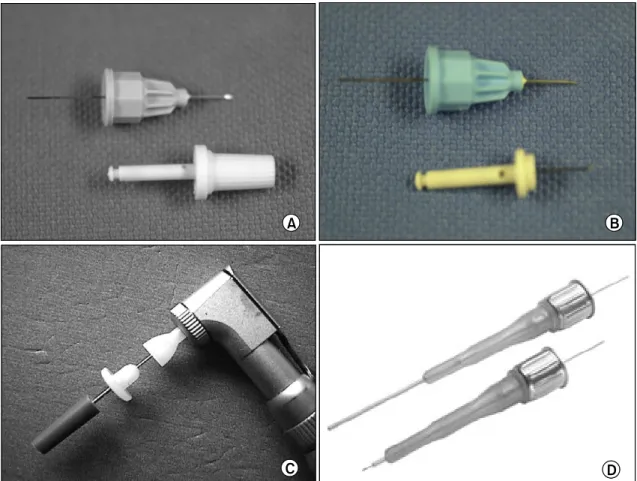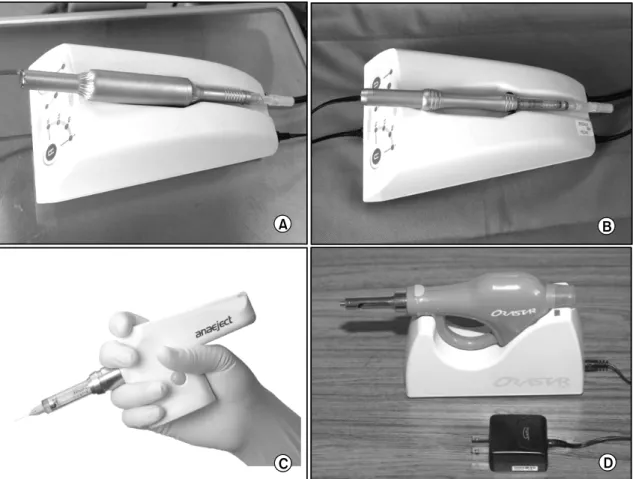대한치과마취과학회지:2003; 3: 71∼79 □
종 설
□71 INTRODUCTION
Almost all the dental procedures are done under local anesthesia. Local anesthesia is inevitable in dental practice. First of all, the dentists should have the same understanding that local anesthesia is straightly leads to great pain sensation. It derives from needle injection of sensitive oral mucosa, poor technique and incomplete topical anesthesia. Dental anesthesia itself has a contra- diction because it gives intolerable pain before painless practice.
TOPICAL ANESTHESIA
At least now, all the effective anesthetic methods need injection needles. Every needle gives the patient prick and injection pain. To diminish the pain, topical or surface anesthesia is often used. However, insuffi- cientanesthetic effect is often recognized during routine dental general practices.
We carried out two clinical studies regarding topical anesthesia. For the firstexperiment, we used topical an- esthetic, 20% benzocaine, or commercially available Hurri- cane. In order to enhance the anesthetic effect, it was put on either side of the attached gingiva of apex of the incisors for 20 minutes and was applied using
strong adhesive (Fig. 1).
After application of the topical anesthetic, the anes- thetized area was sealed with tape and cotton rolls.
The volunteers were kept calm for 20 minutes.
To measure the effect of topical anesthesia, we per- formed 3 kinds of painful stimulation; puncture at 2 mm depth by needle, insertion of the needle to the cortical bone, and injection of 0.9 ml of 2% lidocaine.
We modified the infiltration needles, which have a stopper up to 2 mm of needle depth in order to regu- late the magnitude of pain sensation. For each painful stimulation, pain rating score (PRS) and visual analog scale (VAS) were applied to each volunteer to evaluate the degree of pain. PRS consists of 4 categories of pain; they are no pain, slight pain, pain, and severe pain. The volunteer reports one of them immediately after each stimulation. VAS is 10 cm long line and the left end indicates no pain and the right end means intolerable pain. The volunteer is asked to check one point of line according to a degree of each pain. The result is that there was no difference between the con- trol side and anesthetized side by PRS using 20% ben- zocaine (Fig. 2). VAS did not recognize any difference between the control side and topically anesthetized side, either. These results indicate 20% benzocaine could not diminish needle pain significantly.
On the contrary, 60% lidocaine significantly reduced needle pain: Nineteen out of 20 volunteers answered no pain of needle puncture. PRS was also depressed by concentrated anesthetic even after stimulation by in- jection (Fig. 3). VAS also revealed that 60% lidocaine gel significantly depressed the pain sensation by those
Local Anesthesia in Dental Practice -New Methods of Local Anesthesia
Haruhisa Fukayama
Anesthesiology and Clinical Physiology, Department of Oral Restitution, Division of Oral Health Sciences, Graduate School, Tokyo Medical and Dental University
Correspondence: Haruhisa Fukayama, Anesthesiology and Clinical Physiology, Tokyo Medical and Dental University, 5-45, Yushima 1-chome, Bunkyo-ku, Tokyo, 113-8459, Japan Tel: +81-3-5803-5549, Fax: +81-3-5803-0206 E-mail: fukayama.
anph@tmd.ac.jp
72
Fig. 1. Placement of topical anesthetic. Before topical anesthetic was applied to the apical area of the central incisors, adhesive patches were attached on the area. The area was then covered by surgical tape and cotton rolls.
Fig. 2. Pain rating score by prick, bone and injection and visual analog scale after application of 20% benzocaine.
n
Moderate pain Slight pain No pain Prick
0 15
10
5
n
Severe
pain Noderate
pain Slight
pain No
pain Bone
0 12
8
4 10
6
2
n
Severe
pain Moderate
pain Slight
pain No
pain Injectoin
0 10 8
4 6
2
VAS
Injection Bone Prick
0 100 80 60 40 20
Men+SD Control
Anesthetized
Haruhisa Fukayama:New Methods of Local Anesthesia 73
3 kinds of stimulation. They almost recognized no pain by prick and bone stimulation. Injection of anesthetic caused less pain compared to un-anesthetized side. PRS and VAS were significantly decreased by the topical anesthetic. We succeeded in enhancing topical anes- thesia using concentrated anesthetic.
However, their application time was 20 minutes using special drape. In addition, the 60% lidocaine gel was sample agent. It means the situation is not clini- cally available. Though the same concentrated lidocaine is commercially available as adhesive tape in order to diminish catheterization intravenously, it is contraindi- cated to the oral mucosa. Generally, factors to en- hance topical anesthesia are: more concentrated anes- thetic, longer application time, and modified application method. Further researches are required to discuss addi- tion of absorbents that will accelerate the drug delivery.
NEW ANESTHETIC DEVICES
New devices for local anesthesia have been intro- duced in order to reduce the pain, to relax the patient, and to ensure the anesthesia.
A small device is now commercially available in Japan and the US, called Vibraject (Fig. 4A, B). It is 18 g weight and battery operated machine. The struc- ture is simple enough to be attached to the conven- tional infiltration anesthesia syringe or cartridge. It produces ultrasonic vibration by the motor powered by the batteries. The syringe itself begins to vibrate at a rate of 3,000 Hz to turn it on, which elimina- tespuncture pain at infiltration anesthesia. Thirty injec- tions were given to the volunteers with or without Vibraject vibration. The results by PRS and VAS Fig. 3. Pain rating score by prick, bone and injection and visual analog scale after application of 60% lidocaine.
n
Severe
pain Noderate
pain Slight
pain No
pain Bone
0 20
10 15
5
n
Severe
pain Moderate
pain Slight
pain No
pain Injectoin
0 15
10
5
VAS
Injection Bone Prick
0 100 80 60 40 20
Men+SD Control
Anesthetized
n
Severe
pain Moderate
pain Slight
pain No
pain Prick
0 20
10 15
5
showed no difference was found using Vibraject.
The next new system for local anesthesia is the Wand (Fig. 4C). It has its unique outlook but it can provide the same anesthetic, the same injections and the same pain control. It consists of microprocessor unit, plastic handpiece and foot control. The needle can be handled by pen like grasp and the anesthetic flow is controlled by CPU, switched by foot controller.
Microprocessor unit regulates flow rate precisely in spite of various tissue resistance and the foot controller eliminates hand and arm fatigue. Pen-like grasp facilitates easy, precise and accurate injection. In addi- tion, the needle can be rotated lightly, which enables to designate injection point. It isspecifically advanta- geous for longer insertion technique like inferior alveo- lar nerve block. Rotation of the needle and slow pene- tration can make anesthetic pathway that is followed by the needle and can reduce the penetrating pain at inferior alveolar nerve block.
The new anesthetic system, the Wand, has also serves anterior middle superior alveolar, or AMSA, block of the maxillary nerve (Fig. 5). Single palatal injection leads upper 5 teeth anesthesia without numbing the la- Fig. 4. Vibraject and the Wand. Vibraject (A), Vibraject attached to cartridge (B), the Wand (C).
B A
B C B A A
C C
Fig. 5. Pain rating score by AMSA (Anterior Middle, Superior Alveolar) block by the Wand. Both insertion and injection caused little pain to the volunteers.
n
15
Insertion
Slight pain No pain
0 20
10 5
Severe pain Pain
3
11 14
6
3 3
0 0
Haruhisa Fukayama:New Methods of Local Anesthesia 75
bial or buccal mucosa. According to the manual, AMSA provides anesthesia of the central incisor to the second premolar. We studied the AMSA using the 14 volunteers. Puncture and injection pain was assessed by PRS and VAS. The anesthetized tooth was investigated using Analytic pulp tester every 10 minutes. The injec- tion point is bisect premolars, midway between gingi-
val margin and mid-palatine suture. Puncture and injec- tion pain by the Wand were not so large as expected as in the left slide (Fig. 6). No one complained severe pain by injection. VAS also showed the palate injec- tions were not big deals as concerned. Slower pene- tration and slower flow rate reduced pain even to thepalatal injection as determined by visual analog scale. Analytic pulp tester was used for evaluation of the effect. Each tooth of both anesthetized side and control side was checked every 10 minutes up to 60 minutes after injection. The result showed canine, first premolar and second premolar were more completely anesthetized compared with central incisor and first molar (Fig. 7). It can be concluded that AMSA anes- thesia is good enough to anesthetize the upper 3 teeth with single injection without collateral anesthesia and that it can be used as an alternative method for maxillary aneshesia. The Wand also provides PDL, or Fig. 6. Incidence of pulpal anesthesia in the examined maxillary teeth by the time after injection and the percentage
of 80 readings of pulp tester.
0
Central incsisor
60
20 50
0 100
40 80
10 30 40
60
20
0
Canine
60
20 50
0 100
40 80
10 30 40
60
20
0
Iateral incsisor
60
20 50
0 100
40 80
10 30 40
60
20
*
*
* *
*
* *
* *
0
First premolar
60
20 50
0 100
40 80
10 30 40
60
20
0
First molar
60
20 50
0 100
40 80
10 30 40
60
20
0
Second premolar
60
20 50
0 100
40 80
10 30 40
60
20
*
*
* *
* *
*
*
*
* *
*
Fig. 7. Pulp tester readings of each upper tooth.
Second premolar First molar
Canine First premolar
Central incisor Lateral incisor
55 71
54 60
69 62
19 3
20 14
5 12
<80 >80
periodontal ligament injection, safely and precisely.
Although PDL needs more power to inject anesthetic into periodontium and causes intolerable pain, the machine can provide constant and high pressure, which eliminates damage of periodontium and pain. Because the injection power is supplied electrically, the dentist can concentrate on its injection point and injection direction. Although conventional syringe can deliver PDL, the new injection system can save the power to inject. It is easy to administer, no collateral anesthesia, reduces time of onset, which enables smoother practice.
These days, intraosseous injection has been focused on.
We sometimes suffer from the patients'complaints that they feel pain of lower molars even after sufficient infiltration anesthesia. The concept of intraosseous injec- tion is to inject anesthetic to spongeous bone through
cortical bone. It provides excellent anesthetic effect. The system, which consists of two small needles, is called Stabident that are made in the US (Fig. 8A, B). The penetrating device, the perforator is exactly the same length and diameter as the injection needle. Ithas three steps. At first, the infiltration anesthesia is given to gingivausing the conventional needle as you see in the right slide. Secondarily, the cortical bone was perforated to the spongeous bone by the sharp perforator attached to a contra-angle handpiece at a high speed. Finally, the anesthetic is injected using the specific needle that has the same length and the same diameter as the perforator (Fig. 8C). Intraosseous anesthesia has another alternative system, which is called X-tip and consists of a needle and 2 parts of the perforator. Like Stabident, the spongeous bone was perforated by the thinner and small
Fig. 8. Intraosseous injection devices; Stabident (A, B), X-tip (C), MPL (D).
C
A B
C D C A
A BB
D D
Haruhisa Fukayama:New Methods of Local Anesthesia 77
drill set attached to the contra-angle handpiece. After perforated to the spongeous bone, the upper part of the perforator is removed and the rest is left in the alveolar bone. It is a goodindicator for injecting anesthetic to the spongeous bone. The anesthetic injected by a needle that is the same diameter and length of the remaining perforator. After the injection, the perforator is easily pulled out by a forceps. Our experience shows both Stabident and X-tip work enough to anesthetize both teeth conjugating the injection site.
Hypointraosseous needle, or MPL, is a simple needle system consisted of one part (Fig. 8D). The sharp nee- dle is covered by metal sheath, whichenables easy and tight perforation to spongeous bone. First the gingiva is lightly anesthetized and make a needle progress.
After the sheath is protruded, the inner needle goes
into spongeous bone through the cortical bone. The spongeous bone is then anesthetized.
Sleeper One and Quick Sleeper are the new brands that were developedand now commercially available in Europe (Fig. 9A, B). Both of them provide intraosseous anesthesia like Stabident, X-tip, or MPL. Their unique characters are that Quick sleeper can rotate itself to penetrate into the alveolar bone. The component of the needle and the anestheticcartridge rotates itself. MCCS, or Midwest Comfort Control System is another kind of syringe pump. Apart from the Wand, they have mo- tors, whichdirectly connected to the needles. That is why they are heavy to handle precisely. To use Quick Sleeper, the gingiva is anesthetized by infiltration method and the bone is drilled by Quick Sleeper, followed by anesthetic injection.
Fig. 9. Electric anesthesia systems; SleeperOne (A), QuickSleeper (B), Anaeject (C), Ora Star (D).
C
A B
C D C A
A BB
D D
Those intraosseous injection systems seem to cause great pain when injection to the bone. However, we have had seldom complaints by the patients. One of the reasons is sparse pain points within spongeous bone of the alveolar.
Electric syringe pump systems are also available in our country (Fig. 9C). Anaeject has been currently sold.
It utilizes conventional needle and anesthetic cartridge.
Anaeject has a good competitor, called Orastar (Fig.
9D). Both are easy to use and allow the dentist to concentrate on the site of injection and the penetration of gingiva without hand and arm power, although they are heavy compared to conventional syringe and look shooting pistols.
FUTURE OF LOCAL ANESTHESIA IN DENTISTRY
One of our expectations of future of local anesthesia is continuous injection of anesthetic using catheter.
Epidural or lumber anesthesia often used in the general surgery and the system can be utilized for continuous injection for maxillary or inferior nerve block. Cus- tomized introducer, needle, adapter and extra thin cath- eter are used for the purpose.
Under the sterile circumstances, the catheter is in- serted to round foramen or oval foramen. After the insertion, anesthetic solution is administered like the right slide. We are studying continuous infusion using syringe pump.
Iontophoresis will be an excellent candidate to con- trol the pain in dentistry. Direct current iontophoresis was tried for pain control but was not clinically uti- lized because of severe pain and burn. Altered current iontophoresis is now being investigated vigorously. The optimum condition has been shown by a in vitro study using the specific cell shown in the right slide. The round shaped electrode for altered current iontophoresis will provide better drug delivery. Smallerelectrode is expected. Altered current iontophoresis experimentally utilized for oral and maxillofacial pain clinic. The patch includes lidocaine solution and it can be deliv-
ered percutaneously. The patient has been relieved from pain of oral and maxillofacial region.
This review article was presented at the Third Con- gress and Symposium of the Korean Dental Society of Anesthesiology (June 28, 2003). The author would like to appreciate Professor Yum, Associate Professor Kim and Dr. Park Chang-Joo for their kind assistance.
REFERENCES
Coggins R, Reader A, Nist R, Beck M, Meyers WJ:
Anesthetic efficacy of the intraosseous injection in maxillary and mandibular teeth. Oral Surg Oral Med Oral Pathol Oral Radiol Endod 1996; 81: 634-41.
Donaldson D, Meechan JG: A comparison of the effects of EMLA cream and topical 5% lidocaine on discomfort during gingival probing. Anesth Prog 1995; 42: 7-10.
Hersh EV, Hoput MI, Cooper SA, Feldman RS, Wolff MS, Levin LM: Analgesic efficacy and safery of an intraoral lidocaine patch. Journal of the American Den- tal Association 1996; 127: 1624-34.
Fukayama H, Sunakawa M, Mori M: Researches of enhancement of topical anesthesia in dentistry. Journal of the Japanese Association for Dental Science 2001;
20: 80-5.
Fukayama H, Suzuki N, Umino M: Comparison of topical anesthesia of 20% benzocaine and 60% lidocaine gel.
Oral Surg Oral Med Oral Pathol Oral Radiol Endod 2002; 94: 157-61.
Friedman MJ: New advances in local anesthesia. Compen- dium 2000; 21: 432-40.
Friedman MJ, Hochman MN: A 21st century computerized injection system for local pain control. Compendium 1997; 18: 995-1003.
Friedman MJ, Hochman MN: P-ASA block injection: A new palatal technique to anesthetize maxillary anterior teeth J Esthetic Dent 1999; 11: 63-71.
Friedman MJ, Hochman MN: The AMSA injection: A new concept for local anesthesia of maxillary teeth using a computer-controlled injection system Quintessence Int 1998; 29: 297-303.
Friedman MJ, Hochman MN: The AMSA injection: Anes- thetize the teeth, not the face. Contemporary Esthetics and Restorative Practice 2000; 1: 1-2.
Fukayama H, Yoshikawa F, Kohase H, Umino M, Suzuki N: Efficacy of anterior and middle superior alveolar (AMSA) anesthesia using a new injection system: The Wand. Quintessence Int 2003; 34: 537-41.
Haruhisa Fukayama:New Methods of Local Anesthesia 79
Hochman MN, Friedman MJ: In vitro study of needle deflection: A linear insertion technique versus a bidi- rectional rotation insertion technique. Quintessence Int 2000; 31: 33-9.
Hochman M, Chairello D, Hochman CB, Lopatkin R, Pergola S: Computerized local anesthetic delivery vs.
traditional syringe technique. New York State Dental Journal 1997; 3: 24-9.
Houpt MI, Heins P, Lamster I, Stone C, Wolff MS: An evaluation of intraoral lidocaine patches in reducing needle-insertion. Compendium of Continuing Education in Dentistry 1997; 18: 309-10.
Kinoshita T, Shibaji T, Umino M: Transdermal delivery of lidocaine in vitro by alternating current. J Med Dent Sci 2003; 50: 71-7.
Kohase H, Miyamoto T, Umino M: A new method of continuous maxillary nerve block with an indwelling catheter. Oral Surg Oral Med Oral Pathol Oral Radiol Endod 2002; 94: 162-6.
Krochak M, Friedman N: Using a precision metered injec- tion system to minimize dental injection anxiety. Com- pendium 1998; 19: 137-47.
Lieberman WH: The Wand. Pediatric Dentistry 1999; 21:
134.
Martin MD, Ramsay DS, Whitney C, Fiset L, Weinstein, P: Topical anesthesia: Differentiating the pharmacolo- gical and psychological contributions to efficacy.
Anesth Prog 1994; 41: 40-7.
Meechan JG, Donaldson D: The intraoral use of EMLA cream in children. ASDC 1994; 61: 260-2.
Milestone Scientific: Operating manual, the Wand. 6th ed.
Illinois, Milestone Scientific Dental Revision. 1999, 25 Miura K, Beppu S, Sato Y, Sekita S, Amemiya Y: A study
of the effectiveness of topical anesthetic (Penles) on the oral mucosa. JJDSA 1997; 25: 174-7.
Oldak SB, Jackson LA: The Wand. J Southeastern Soc
Pediatric Dentistry 1999; 5: 38.
Replogle K, Reader A, Nist R, Beck M, Weaver J, Meyers WJ: Anesthetic efficacy of the intraosseous injection of 2% lidocaine (1:100,000 epinephrine) and 3% mepi- vacaine in mandibular first molars. Oral Surg Oral Med Oral Pathol Oral Radiol Endod 1997; 83: 30-7.
Shibaji T, Yasuhara Y, Oda N, Umino M: A Mechanism of the high frequency AC iontophoresis. Journal of Controlled Release 2001; 73: 37-47.
Stabile P, Reader A, Gallatin E, Beck M, Weaver J:
Anesthetic efficacy and heart rate effects of the intraosseous injection of 1.5% etidocaine (1:200,000 epinephrine) after an inferior alveolar nerve block. Oral Surg Oral Med Oral Pathol Oral Radiol Endod 2000;
89: 407-11.
Svensson P, Petersen K: Anesthetic effect of EMLA oc- cluded with orahesive oral bandages on oral mucosa. A placebo-controlled study. Anesth Prog 1992; 39: 79-82.
Svensson P, Petersen JK, Svensson H: Efficacy of a topi- cal anesthetic on pain and unpleasantness during scaling of gingival pockets. Anesth Prog 1994; 41: 35-9.
Taware CP, Mazumdar S, Pendharkar Adani MH, Deva- raja PV: A bioadhesive delivery system as an alterna- tive to infiltration anesthesia. Oral Surg Oral Med Oral Pathol Oral Radiol Endod 1997; 84: 609-15.
Umino M, Kohase H, Ideguchi S, Sakurai N: Long-term pain control in trigeminal neuralgia with local anesthet- ics using an indwelling catheter in the manidibular nerve. The Clin J of Pain 2002; 18: 196-9.
Yomosa H, Nagahata T, Nakahashi K, Yokoyama T: The effect of lidocaine tape in children. J Clin Anesth 1996;
20: 195-7.
Yoshikawa F, Ushito D, Ohe C, Shiraishi Y, Fukayama H, Umino M: Vibrating dental local anesthesia attach- ment to reduce injection pain. JJDSA 2003; 31: 194-5.
